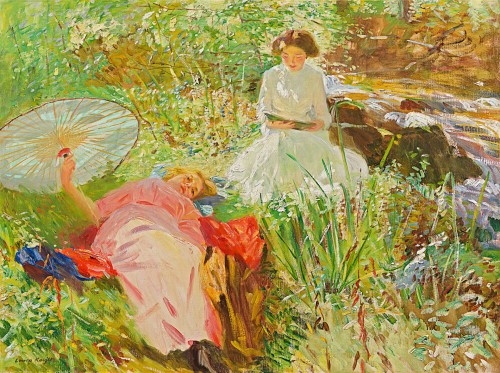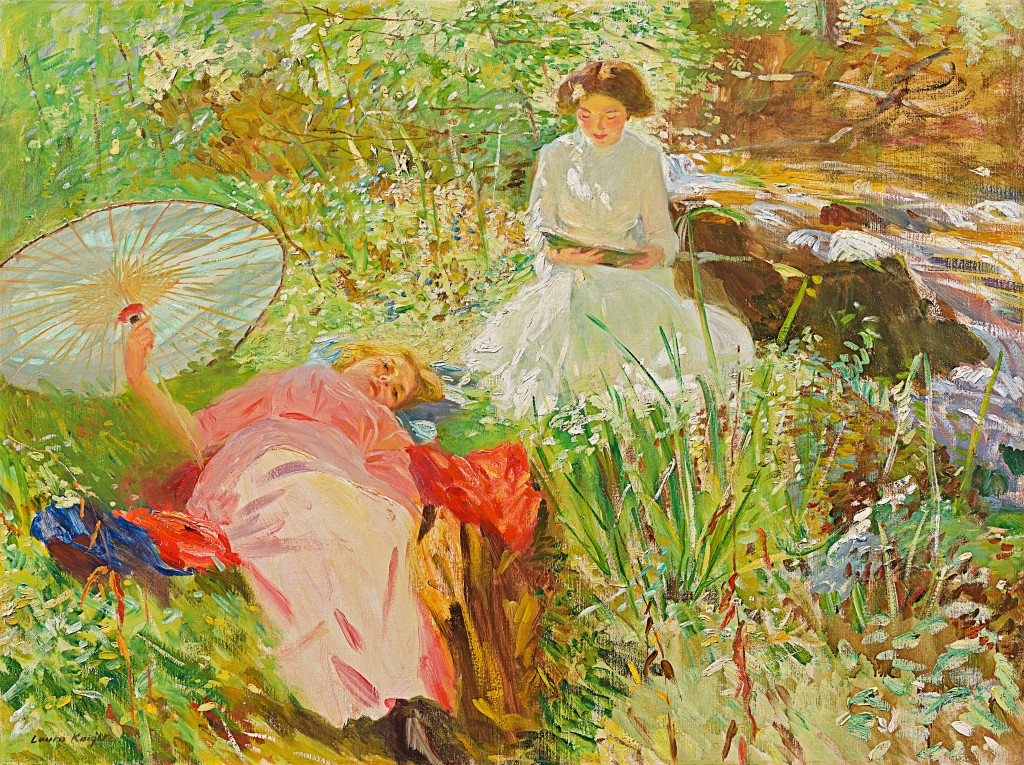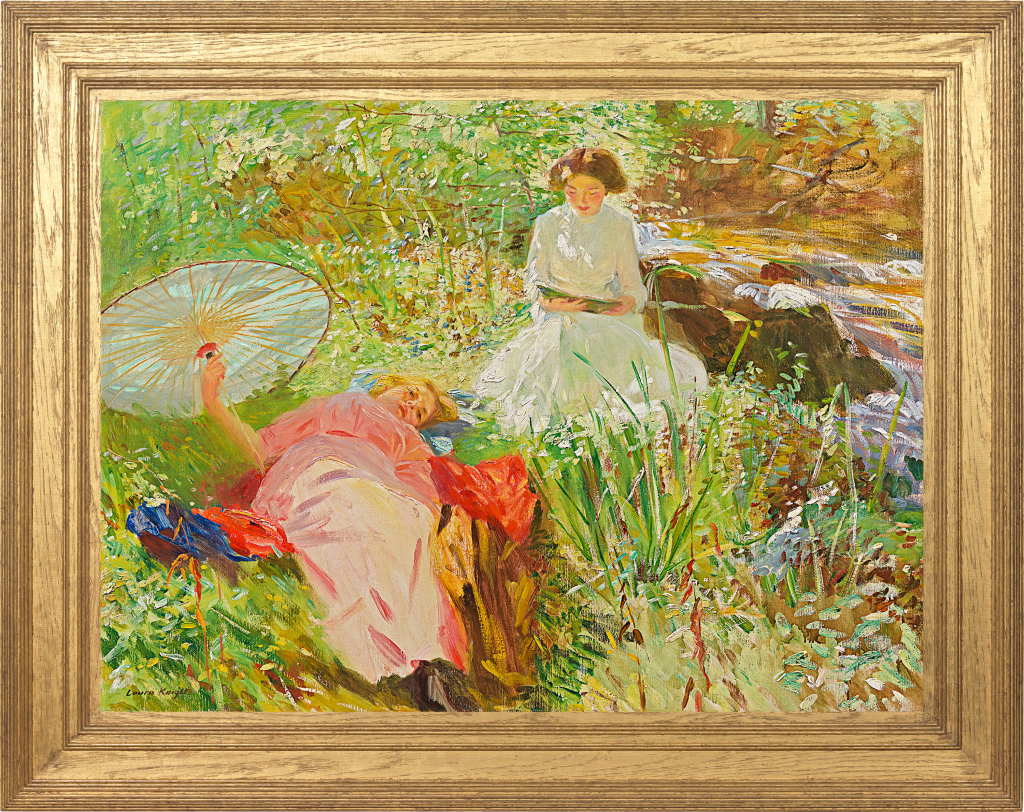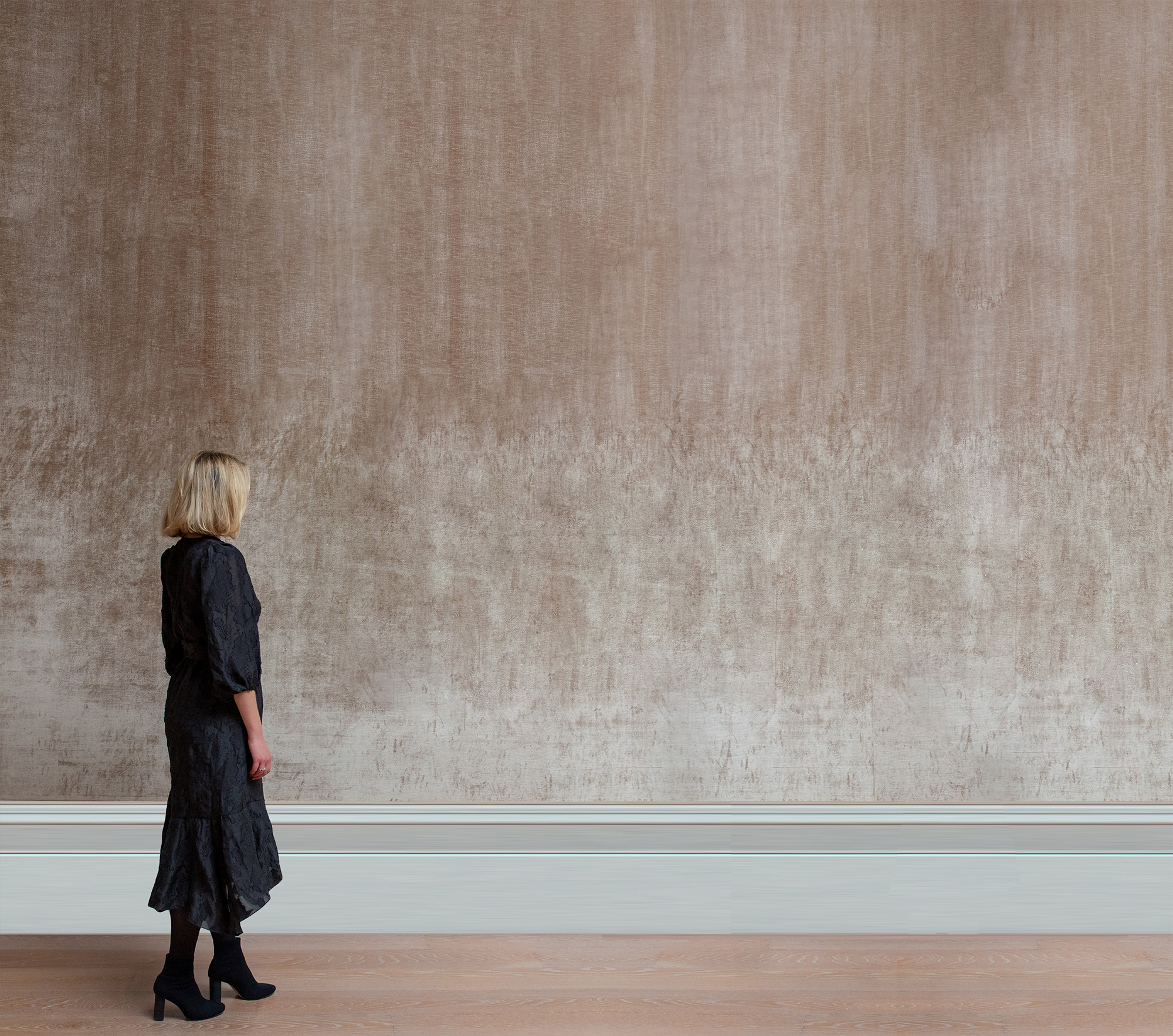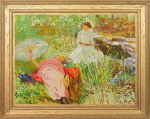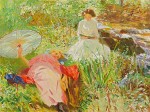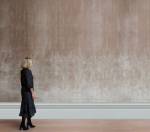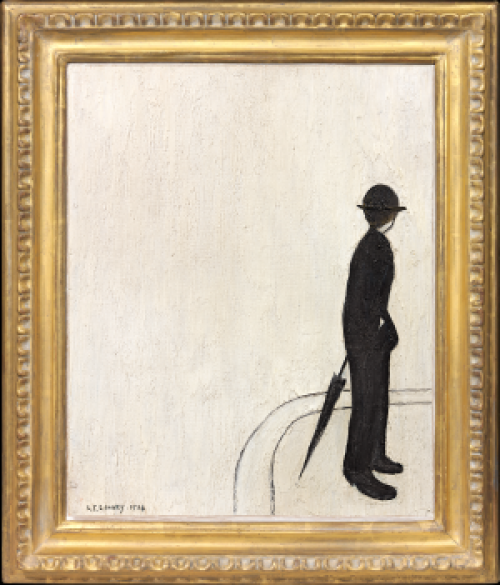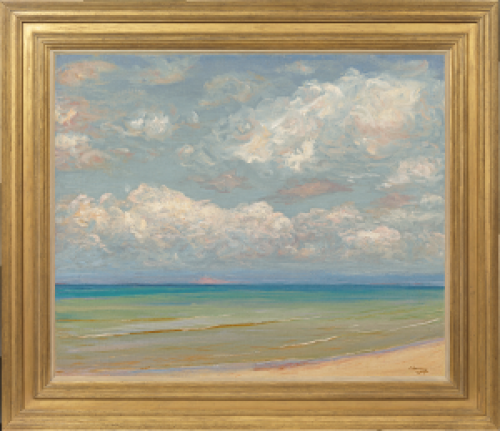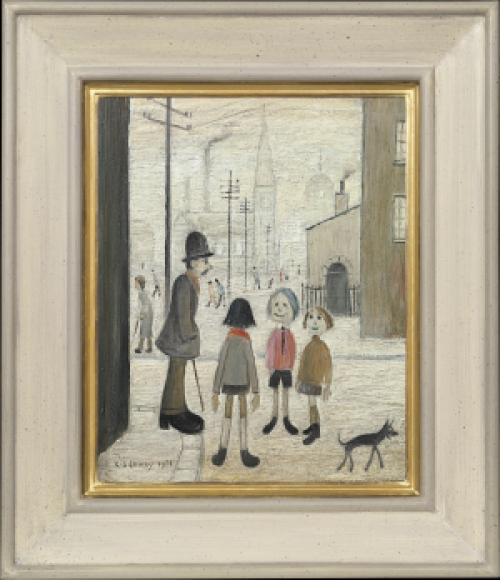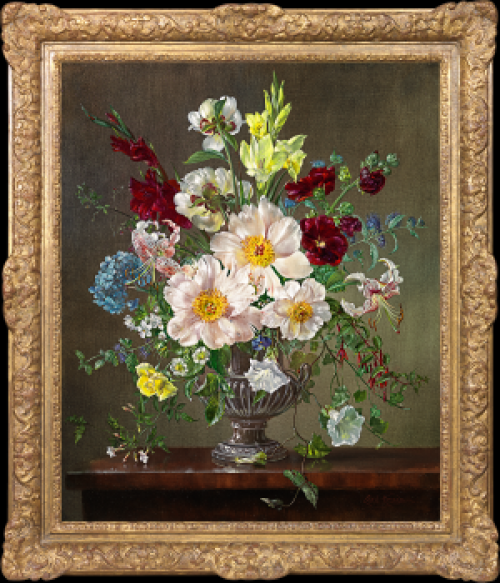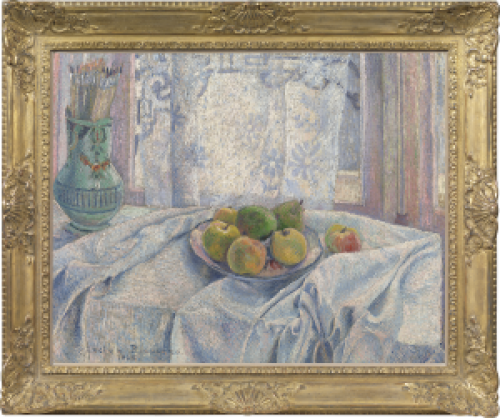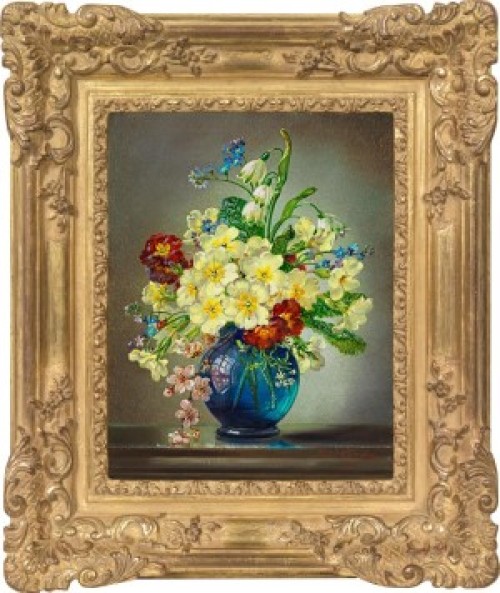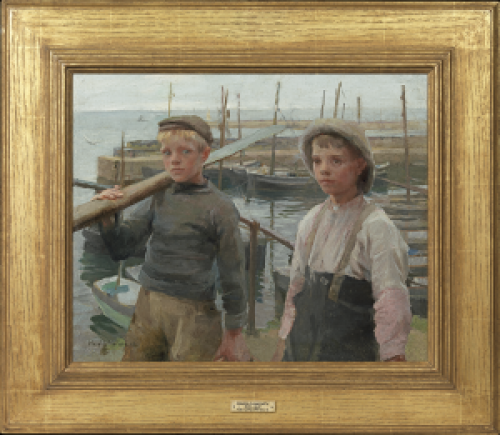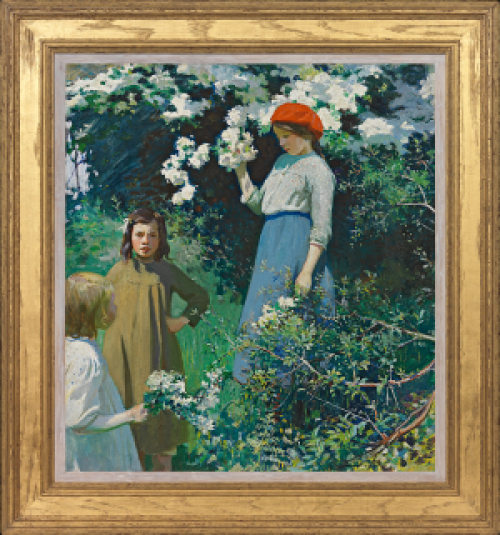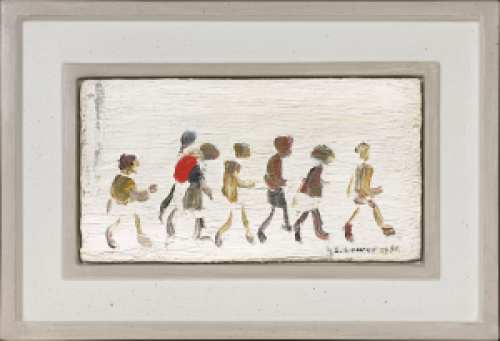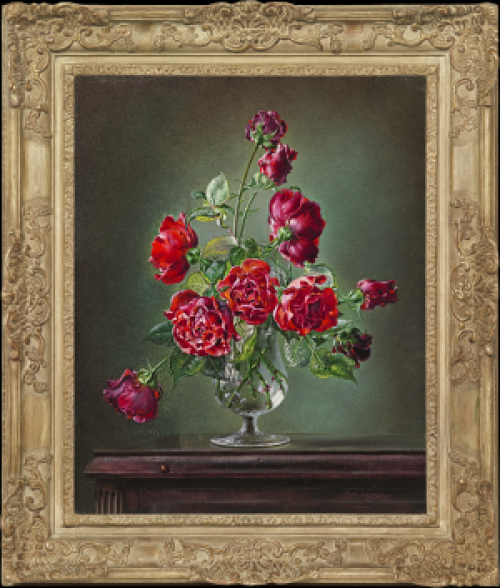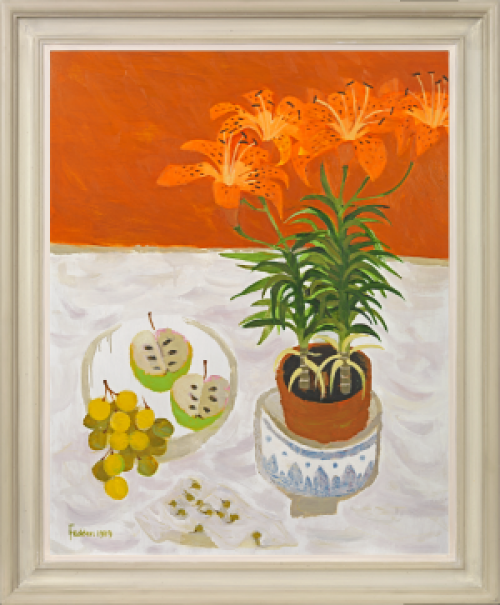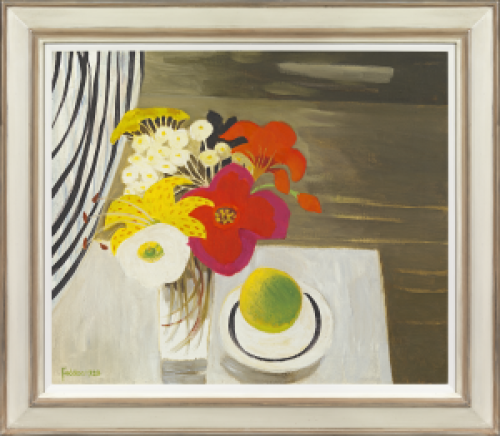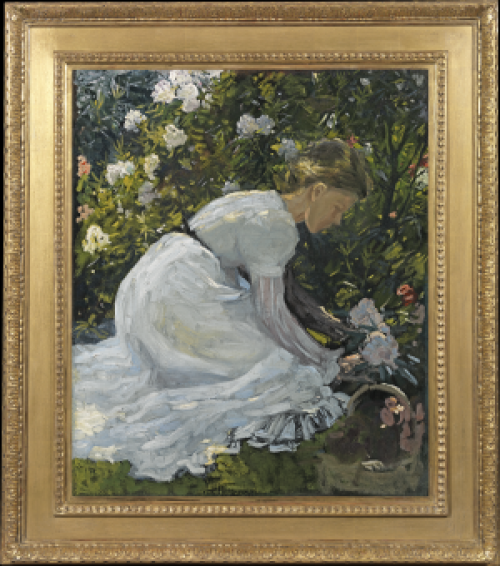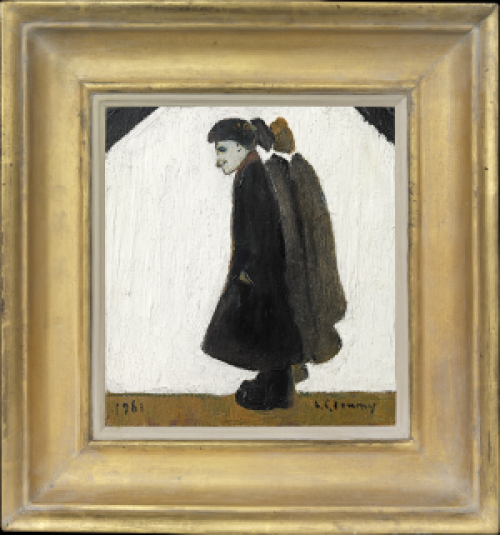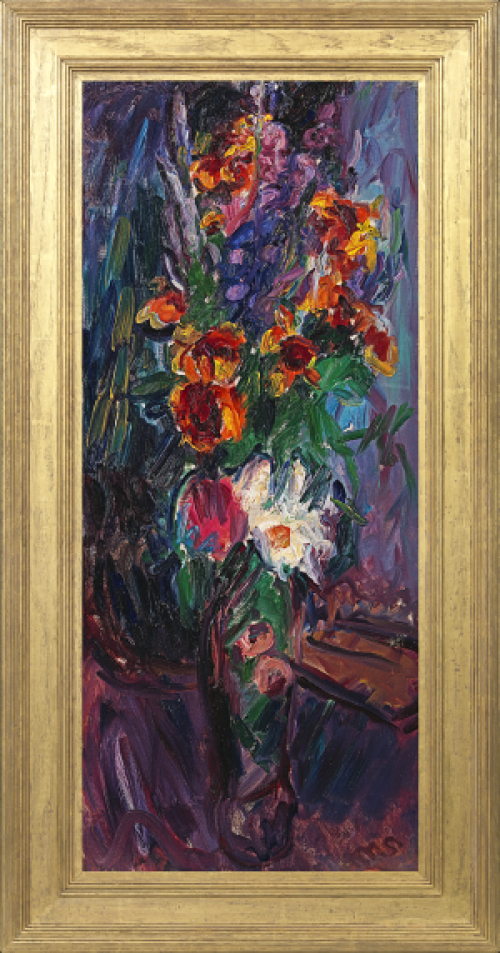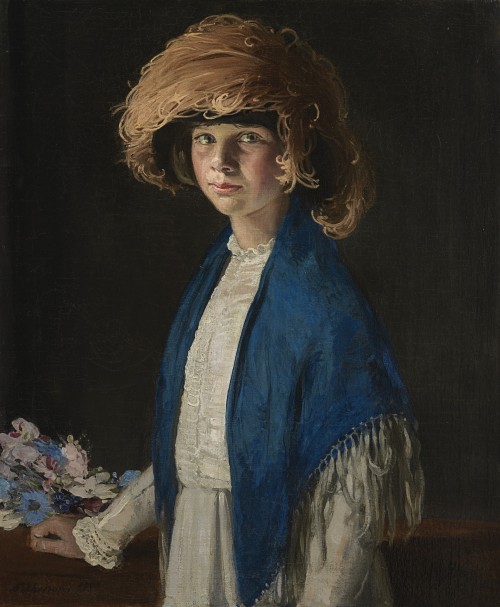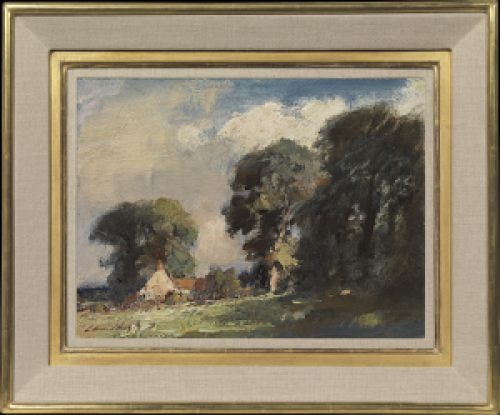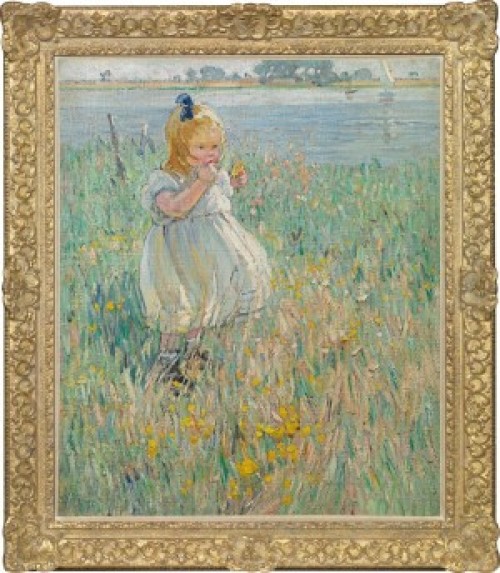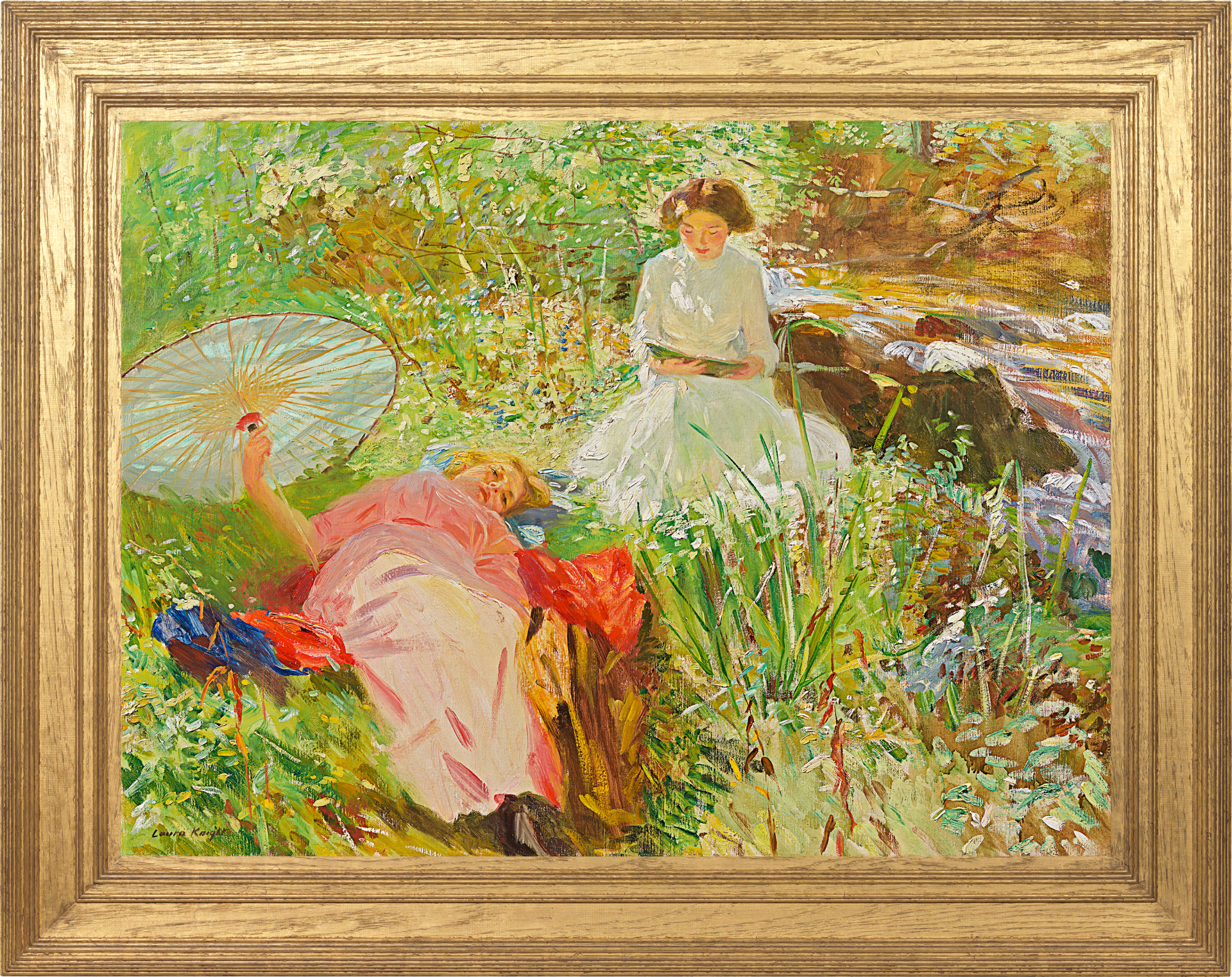DAME LAURA KNIGHT DBE RA RWS RE RWA PSWA
Long Eaton, Derbyshire 1877 - 1970 London
Ref: CD 170
Full summer (By the stream)
Signed lower left: Laura Knight
Oil on canvas: 30 x 40 in / 76.2 x 101.6 cm
Frame size: 40 x 50 in / 101.6 x 127 cm
In a reeded Whistler style carved and gilded oak frame
Painted circa 1910
Provenance:
John A Cooling, London;
RL Patterson, Canada, acquired from the above 27th January 1913, then by descent
Exhibited:
London, William Marchant & Co., The Goupil Gallery, The Goupil Gallery Salon, October-December 1910, no.71, as Full summer
Bradford, Corporation Art Gallery, Cartwright Memorial Hall, Eighteenth Spring Exhibition, 1911, no.236, as Full summer
Toronto, Matthews Art Gallery, Exhibition of Modern Pictures: The Collection of John A Cooling & Sons, London, 1913, no.8, as By the stream
Toronto, Grange Park, Art Gallery of Toronto, long term loan, circa 1930s
Literature:
Anon, ‘Goupil Gallery Salon: Four Nottingham Artists Represented: Modern Art Triumphant’, The Nottingham Guardian, 20th October 1910, p.10
Anon, ‘The Goupil Salon’, The Daily Telegraph, 25th October 1910, p.7
Martin Hardie, ‘The World of Art: The Goupil Gallery Salon’, The Queen: The Lady’s Newspaper, 29th October 1910, p.792
Laurence Binyon, ‘Post-Impressionists’, The Saturday Review, 12th November 1910, p.609
Anon, ‘Bradford Art Gallery: Spring Exhibition’, The Yorkshire Post, 4th March 1911, p.9
Anon, ‘Show English Painters’, The Gazette, Montreal, 17th September 1912, p.2
‘… by force of elemental passion nature has opened up her own paintbox. See her sweep across the landscape a blue-black storm. Now watch her efface that darkness with a brush-full of gold.’[1]
Thus, Laura Knight described her lasting memory of the west Cornwell landscape. Working en plein air in such a setting, she must seize the moment. She later admitted that working on The beach (Laing Art Gallery, Newcastle upon Tyne), her first important Newlyn canvas, she remained rooted in practices honed for colder coastlines, but by 1909, acclimatisation to her new environment began to be more fully reflected in her work.[2]
Laura and Harold Knight had arrived in Penzance in November 1907, having spent a severe winter at the artists’ colony at Laren in Holland, followed by an unproductive summer at Runswick Bay on the Yorkshire coast where they had worked after their student days in the late 1890s. In Cornwall, while her husband specialised in painting domestic interiors, Laura braved the windswept hillside to produce sketches for Flying a kite and stood in the sun in the Newlyn harbour bowl painting children for Boys, both shown at the Royal Academy in 1910 (figs 1&2).
Fig 1 Laura Knight, Flying a Kite, 1910, 59 x 71 in Fig 2 Laura Knight, Boys, 1910, 60 x 72 in
Iziko, South African National Gallery, Cape Town Johannesburg Art Gallery, South Africa
In both, spontaneity was contrived. Working from oil sketches she devised her compositions, managing foregrounds and dramatizing the prevailing light and atmosphere. School abandoned, the Penwith peninsula in these first Newlyn summers was a haven for children’s play, and Knight’s set-pieces, cunningly conceived, ensured popularity and a prominent place on the Academy ‘line’. So appealing were they that ‘no painter has realised the joyousness of sunlight in a more remarkable degree’ wrote one reviewer in response to her efforts.[3] Boys had been compared with the work of Henry Scott Tuke and for its companion she had readily relied upon the catholicity of Newlyn contemporaries such as Harold Harvey and Norman Garstin. Surveying recent works including In the orchard, circa 1909, or In the sun, 1909 (Private collection) for instance, her proximity to Harvey’s Blackberry harvest, 1908, was all too obvious (figs 3&4).
Fig 3 Laura Knight, In the Orchard, c. 1908 Fig 4 Harold Harvey, Blackberry Harvest, 1908
Watercolour, 23 ½ x 19 ½ in, Private Collection oil on canvas: 16 x 14 in, Private Collection
As they sped off to important collections in South Africa not to be seen again, Flying a kite and Boys marked a watershed. There was a sudden unease about the pinafores and straw hats that signified the Newlyn genre painter. Knight’s restless creativity was taking her elsewhere. New ambitions were emerging and if to remain in the south-west, she must break with convention. She must go deeper. Métier and subject matter must be overhauled. What had been the stuff of studies, that vital freshness of lived experience, must rise to the surface and take its place in the completed work. Driven by the wish to revise the classical arcadia by bringing the female nude out into the open air she must import professional models – as the French Post-Impressionists were doing. For the first inkling of this fundamental pivot towards international modernism we look to the recently rediscovered Full summer.[4]
Throughout their years in Cornwall, the Knights spent ‘some months every year’ in London, and although preoccupied by the theatre, we can assume awareness of contemporary trends in the art world, while staging their own joint exhibitions at the Leicester Galleries.[5] In addition to attending the Royal Academy Summer shows, connections were made with William Orpen and Augustus John, and there must have been forays into the current exhibitions of the New English Art Club where John Singer Sargent, having brushed aside his portrait practice, was baffling critics with new exercises in plein air painting. Works like The Brook, 1907, Dolce far niente, circa 1907 (Brooklyn Museum) and The Black Brook, 1909 (Tate) looked back to the well-springs of British Impressionism when the American painter was especially close to Monet and painting canvases such as St Martin’s Summer (figs 6&7).
Fig 6 John Singer Sargent, The Brook, 1907 Fig 7 John Singer Sargent, St Martin’s Summer, 1888
21 ½ x 27 in, Private collection 36 x 28 in, Private collection
Sargent’s more recent New English offerings, from the so-called ‘Zuleika’ series, showed figures dressed in exotic costumes, lying on the banks of an Alpine stream at Purtud in Switzerland. Painted ad vivum, with dramatic foreshortening, they were not universally praised.[6] Yet it was clear, even in the club’s 1907 winter exhibition that Sargent’s ‘confused mass of sky and tree reflections’ in The Brook had a significant following.[7]
To move in this direction Knight, like Sargent, required imported models whose pliant performativity could be relied upon and who must not pose in any conventional sense, but behave normally, reading and relaxing in the sunlit glade.[8] Intimacy was essential. These young Londoners had no experience of the countryside and were hired and billeted in a cottage at the top of the secluded Lamorna Valley, adjacent to that of the artist.[9] Seeing them daily, following the track of the little stream down to the sea, finding places to paint, Knight was captivated.[10] So ideal was her situation that in works like Full summer she found it difficult to control her enthusiasm. She later recalled,
From what I remember of the pictures I exhibited they were an expression of joie de vivre from which I was suffering. An ebullient vitality made me want to paint the whole world and say how glorious it was to be young and strong …[11]
Such optimism was obvious to Knight’s most perceptive critic, the poet and curator, Laurence Binyon.[12] Recognising that the Goupil Salon, in which Full summer was being shown, had opened at the same time as Roger Fry’s much-vaunted Manet and the Post-Impressionists exhibition at the Grafton Gallery, he was keen to take its organiser to task. Fry had led his critics through the recent ‘isms’ of French art, claiming that this was the true path and every other contemporary painter had ‘lost his way in a fog’. The only yardstick, apparently, was that provided by Van Gogh, Gauguin, Picasso and Matisse. Binyon recoiled, ‘one cannot write the history of modern art from the standpoint of a Parisian coterie’ and turning to the Goupil Gallery, he observed that ‘…among modern idylls the Full summer of Mrs. Knight stands out by its gaiety of colour and graceful vigour’. Modern Art was a broad church and Knight’s claim to a seat at the high table was a valid one – even though English, and a woman.
The ambition articulated in the present painting, extended to Daughters of the sun (fig 8) in which the same models divest in the secluded Lamorna Bay. A luminous address to the luxe, calme et volupté that Matisse had essayed, it won plaudits, but no purchaser.[13]
Fig 8 Laura Knight, Daughters of the Sun, 1911, destroyed
from Charles Marriott and Edouard J Claes, Allies in Art, n.d. (c. 1917, Colour Ltd), plate X.
In later years with different models, pairs of young women on hilltops and among rocks by the sea would come to dominate Knight’s art. Even when the arrival of the Ballets Russes drew her for longer periods to London, her essential Cornwall was in moments of reverie in the scented air of a full summer. ‘Youth and sunshine’, wrote ‘Tis’ in 1917, ‘has been the keynote of Knight’s high-spirited art, and her high spirits have been infectious’.[14] It is true to say that iconic gouaches such as Wind and sun, and In the fields (both 1911-12, Private collections), would not have been possible without Full summer. Its sparkling palette exemplifies the very epitome of ‘the Indian summer of civilization’ that Adrian Bury later found in Knight’s Cornwall ‘before the first great war’.[15] Its rediscovery at this time is a moment to savour.
Kenneth McConkey, author of British Impressionism, 1989.
[1] Laura Knight DBE RA, The Magic of a Line, William Kimber, 1965, p.136.
[2] Laura Knight, Oil Paint and Grease Paint, Penguin ed., vol 1, 1936/1941, p.173.
[3] ‘The Royal Academy Revisited’, Lady’s Pictorial, 21st May 1910, p.879.
[4] Shown in Britain as Full summer, the work was exhibited by John A Cooling in Canada from late 1912 as By the Stream, and purchased by a private collection in Canada under that title.
[5] The Knights staged exhibitions at the Leicester Galleries (Ernest Brown and Phillips) in 1906, 1907 and 1908. These were mostly drawn from work produced on their visits to Holland.
[6] Richard Ormond and Elaine Kilmurray, John Singer Sargent, Figures and Landscapes, 1900-1907, Complete Paintings Vol VII, Yale University Press, 2012, p.284 (no 1398). When shown at the NEAC in November 1907, as the Knights were embarking for Newlyn, The Brook was accompanied by De Glehn’s version of the same subject.
[7] ‘New English Art Club’, The Ladies’ Field, 30th November 1907, p. 500.
[8] John Croft, in correspondence with Richard Green, has identified the models as ‘Marjorie Taylor lying on the ground holding an umbrella and Beatrice Stuart sat reading a book, relaxing beside the stream flowing into Lamorna Cove, Cornwall painted circa 1912’. He adds ‘little is known on Beatrice except that she was one of the three models referred to by the artist in her biographies as having been brought down from London just before the First World War. Marjorie Taylor, born May 1900 was the daughter and eldest child of Theodora and Charles Lawrence Taylor, the owner of a local coal and hardware merchant’s business in Penzance, Cornwall. Shortly after the birth of her young brother John in 1911, Marjorie’s parents separated and her mother and her children were then supported by her mother’s brother, the manager of Bolitho’s Bank in Penzance’.
[9] Knight recounts that during this summer ‘Benjy’ the son of William Benjamin Leader (1831-1923), the Victorian landscape painter, lent the Knights his ‘furnished cottage’ by Lamorna Gate; see Knight 1936, p.181.
[10] She later recalled, ‘both models had beautiful figures, the fair girl’s was a revelation; I never saw such grace’, see Knight 1936, p.181.
[11] Ibid, p.192.
[12] As with the reactions to Sargent’s ‘Zuleika’ series, Binyon’s enthusiasm for Knight was not universally shared – see for instance the comments by Martin Hardie in The Queen on Full summer. Others, the normally conservative Daily Telegraph for instance, praised its vigour and audacity, ‘based on observed truth’, referring overall to ‘unfeigned joie de vivre’.
[13] When Knight’s models began to attract the attention of local children, they were ‘packed off’, and others employed. Daughters of the sun then ‘did the rounds’ of provincial exhibitions, where it suffered irreparable damage before being destroyed by the artist; see Knight 1936, p.182.
[14] ‘Tis’ [Herbert Furst], ‘Laura Knight: Her Place in Art’, Colour, March 1917, p.56.
[15] Adrian Bury, ‘Dame Laura Knight, DBE, RA, RWS, RE, Hon LLD’, The Old Watercolour Society’s Club, The Thirty-Ninth Annual Volume, 1964, p.14.

